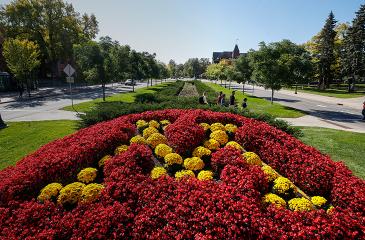Fourth-year medical student, Mickey McDonough visited chemistry and anatomy classes in rural Minnesota to demonstrate suture techniques and answer questions on careers in health care.
Last year, Mickey McDonough participated in the Medical School’s Rural Physician’s Associate Program (RPAP), a nine-month, community-based educational experience for third-year medical students who live and train in rural communities across Minnesota and western Wisconsin. RPAP students experience hands-on learning. They work with SimPORTAL, now a part of M Simulation, twice throughout the nine-month program and learn different procedures like skin prepping, how to place an IV, stitch together a laceration, and prepare and maintain a sterile field. They are later tested on these skills while interacting with a hybrid patient who presents with injuries after an accident. They are observed by faculty and evaluated in real-time.
With this repertoire of skills under her belt, Mickey gave a tutorial recently to 60 students at Waterville-Elysian-Morristown High School on how to properly close a laceration. Waterville is a small town in Southern Minnesota with a population of approximately 1,867 people. There are few clinics in Waterville and less than a handful of medical providers. The nearest city, Mankato is 22 miles away.
Mickey’s husband, Jon, is one of the science teachers at Waterville-Elysian-Morristown, which has a focus on STEM this year. They discussed opportunities for students to gain more STEM exposure as many are unfamiliar with the different career options or what training entails.
“I got the original idea for classroom engagement with the Brain Awareness program, as part of the curriculum on the Duluth campus, and enjoy finding different ways to connect with each class that my husband has through their interests in medicine,” said Mickey.
 M Simulation lent equipment for the suturing demonstration. They have expertise in all aspects of conducting simulations – from developing scenarios based on cutting-edge research, to utilizing standardized patients and human patient simulators, to the science behind effective debriefing and evaluation. They are committed to community outreach and serve University faculty, staff, and students as part of health sciences curriculum and continuing professional development.
M Simulation lent equipment for the suturing demonstration. They have expertise in all aspects of conducting simulations – from developing scenarios based on cutting-edge research, to utilizing standardized patients and human patient simulators, to the science behind effective debriefing and evaluation. They are committed to community outreach and serve University faculty, staff, and students as part of health sciences curriculum and continuing professional development.
During the visit to the high school, Mickey asked students what they were most interested to learn and many responded with “hands-on procedures.”
The day before, Jon and other local teachers showed students a YouTube video and a suture lab handout to help familiarize them with the different instruments and techniques for the presentation. Mickey used a scalpel to make incisions on pig feet and fetal pigs. High school students were given time to close the laceration with suture material such as iris scissors, needle drivers, and Adson forceps, while Mickey guided them and helped answer any questions. Grapefruit and bananas were available for students that were uncomfortable with animal subjects. High school students were engaged in the presentation and asked insightful questions about the different responsibilities of advanced practice providers versus physicians, the variety of specialties, and schooling required.
 Mickey is interested in pursuing more opportunities for engagement at the rural high school and hopes to do another health care workshop on a different topic in the spring.
Mickey is interested in pursuing more opportunities for engagement at the rural high school and hopes to do another health care workshop on a different topic in the spring.
“I thoroughly enjoyed teaching the students how to suture at Waterville-Elysian-Morristown and answering their questions about health care careers and training,” said Mickey. “It was fun to see them gain confidence and hear their perspectives on health care.”



